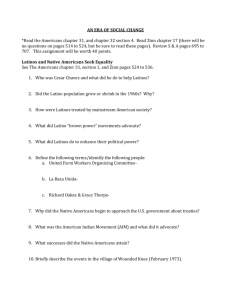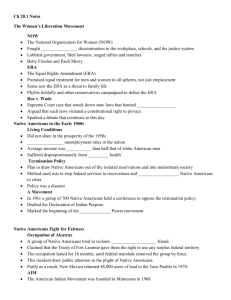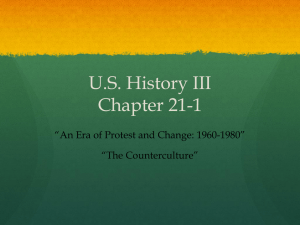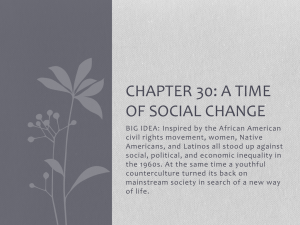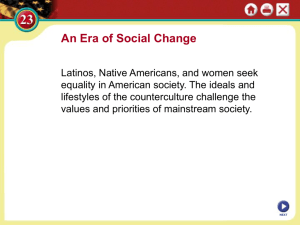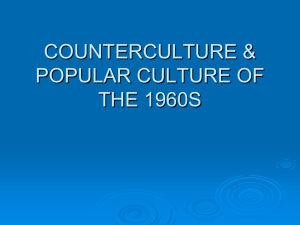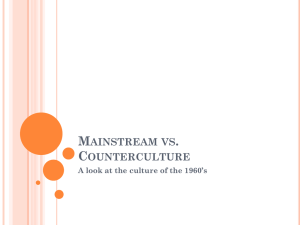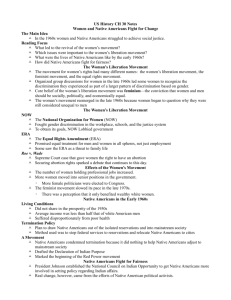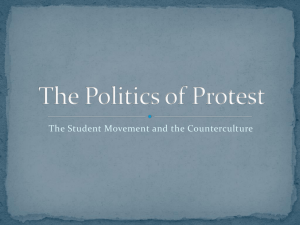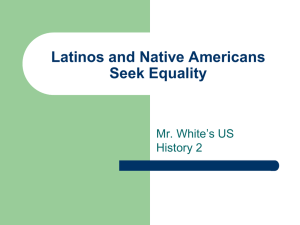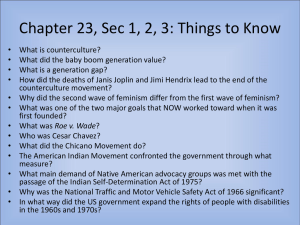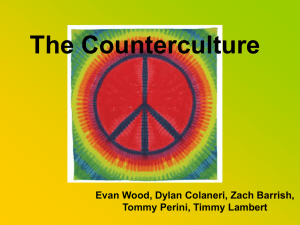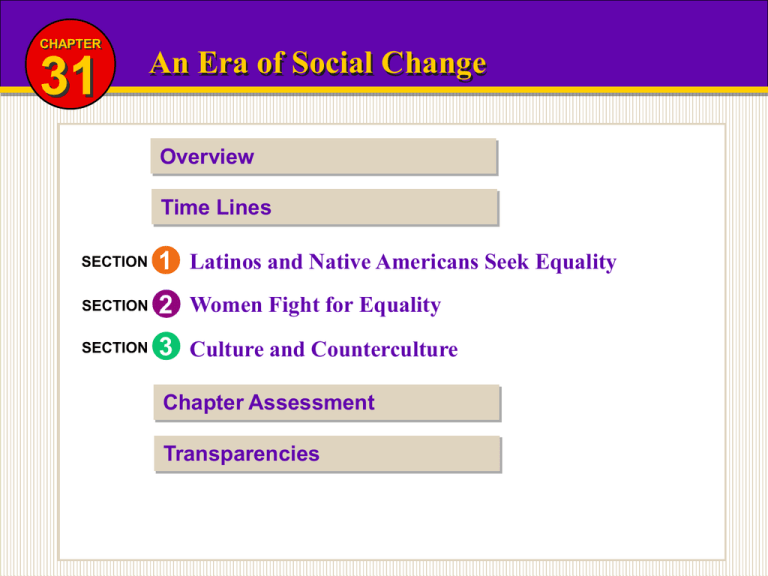
CHAPTER
31
An Era of Social Change
Overview
Time Lines
SECTION
1 Latinos and Native Americans Seek Equality
SECTION
2 Women Fight for Equality
SECTION
3 Culture and Counterculture
Chapter Assessment
Transparencies
CHAPTER
31
An Era of Social Change
“The times they are a-changin´.”
Bob Dylan, singer
THEMES IN CHAPTER 31
Immigration and Migration
Civil Rights
Women in America
The American Dream
HOME
CHAPTER
31
An Era of Social Change
What do you know?
• What images or symbols come to mind when
you think about the 1960s?
• What people—including politicians, musicians,
and activists—helped shape the 1960s?
HOME
CHAPTER
31
Time Line
The United States
1962 Cesar Chavez and Dolores Huerta found
the National Farm Workers Association.
1966 National Organization for Women (NOW) is
formed.
National Farm Workers Association merges
with another farm workers union to form the
United Farm Workers Organizing Committee.
1967 Twenty-fifth Amendment to the U.S.
Constitution, providing guidelines for
presidential and vice-presidential succession,
takes effect.
1968 Native American activists found American
Indian Movement (AIM).
1970 Political party La Raza Unida is formed.
1972 Congress passes Equal Rights Amendment.
1975 Congress passes Indian Self-Determination
and Education Assistance Act.
HOME
CHAPTER
31
Time Line
The World
1962 Chinese forces invade India.
1963 Civil war breaks out between Greeks and
Turks on Cyprus.
1967 Six-Day War erupts between Israel and
Arab nations.
1969 President Charles de Gaulle of France
resigns.
1970 Anwar el-Sadat becomes president of
Egypt.
1971 General Idi Amin Dada seizes power in
Uganda.
1972 Earthquake kills 10,000 in Nicaragua.
HOME
SECTION
1
Latinos and Native Americans Seek Equality
HOME
Learn About
the problems faced by Latinos and Native Americans.
To Understand
their campaigns for civil rights and economic justice.
SECTION
1
Latinos and Native Americans Seek Equality
Key Idea
The nation’s Latinos and Native Americans
demand greater equality in housing,
employment, education, and political
representation.
HOME
SECTION
1
Latinos and Native Americans Seek Equality
Section 1 Assessment
SUMMARIZING
What were the broad similarities between the issues faced by
Latinos and Native Americans during the 1960s? What were
each group’s unique concerns?
SIMILARITIES
LATINOS
Desire for
greater
assimilation
into
mainstream
society
Great diversity within both groups
Pride in their cultural heritage
Concerns over their children’s education
Political activism
High unemployment
Poverty
Second-class citizenship
Militant factions
Victims of prejudice
NATIVE
AMERICANS
Desire to remain
outside
mainstream
society with
greater
autonomy
HOME
SECTION
1
Latinos and Native Americans Seek Equality
Section 1 Assessment
SYNTHESIZING
What criteria would you establish for judging the
effectiveness of an activist organization?
THINK ABOUT
• UFWOC, MAPA, and La Raza Unida
• AIM and the Indians of All Tribes
• the leaders and activities of these organizations
HOME
SECTION
1
Latinos and Native Americans Seek Equality
Section 1 Assessment
CONTRASTING
How did the Native American movement of the 1960s differ
in general from the civil rights struggle of African Americans
and Latinos?
THINK ABOUT
• Vine Deloria, Jr.’s statement
• the Declaration of Indian Purpose
• the goals of AIM
• African Americans’ and Latinos’ desire for greater
assimilation in mainstream society
HOME
SECTION
2
Women Fight for Equality
HOME
Learn About
the social and economic barriers that women faced in
American society.
To Understand
the rise of a new and diverse women’s movement
during the 1960s.
SECTION
2
Women Fight for Equality
Key Idea
A new feminist movement emerges during
the 1960s, as women fight to improve their
opportunities and status in society.
HOME
SECTION
2
Women Fight for Equality
HOME
Section 2 Assessment
SUMMARIZING
What were some key events relating to the women’s movement?
1963
Betty Friedan
publishes The
Feminine Mystique.
1966
National
Organization for
Women is formed.
1970
Demonstration
commemorates 50th
anniversary of woman
suffrage.
1973
Supreme Court’s
ruling in Roe v. Wade
legalizes abortion.
1972
Ms. is founded.
Congress passes Equal
Rights Amendment and
bans sex discrimination
in federally assisted
educational programs
and activities.
SECTION
2
Women Fight for Equality
Section 2 Assessment
HYPOTHESIZING
What if the Equal Rights Amendment had been ratified?
Speculate on how women’s lives might have been different.
THINK ABOUT
• rights addressed by the amendment
• legal support that the amendment might have provided
• possible reactions from groups opposing the amendment
HOME
SECTION
2
Women Fight for Equality
Section 2 Assessment
FORMING AN OPINION
In 1976, Betty Friedan wrote, “We have lived the second
American Revolution.” Do you think she is overstating the
historical importance of the women’s movement by
comparing it to the American Revolution?
THINK ABOUT
• the movement’s legacy
• what you already know about the American Revolution and
its outcome
HOME
SECTION
3
Culture and Counterculture
HOME
Learn About
the ideals and lifestyle of the counterculture movement
of the 1960s.
To Understand
its impact on young people in the 1960s and beyond.
SECTION
3
Culture and Counterculture
Key Idea
Groups of disillusioned youths shun the social
activism of the times and choose instead to
“drop out” of society and establish their own
way of life.
HOME
SECTION
3
Culture and Counterculture
HOME
Section 3 Assessment
SUMMARIZING
What were some examples of the counterculture’s beliefs, lifestyle,
and impact on society?
The Counterculture
Beliefs
• rejection of mainstream
society’s materialism and
technology
• opposition to war
• vision of a society filled with
peace, love, and harmony
Lifestyle
Impact on Society
• rock ´n´ roll music
• outrageous clothing
• drug use
• communal living
• pop art
• men’s and women’s fashions,
especially blue jeans
• rock ´n´ roll
• conservative backlash
SECTION
3
Culture and Counterculture
Section 3 Assessment
3
COMPARING AND CONTRASTING
Draw parallels between the Woodstock rock concert in
upstate New York and the Rolling Stones rock concert in
California. What do you think were the key similarities and
differences?
THINK ABOUT
• what each event came to symbolize
• the prevailing atmosphere at each event
HOME
SECTION
3
Culture and Counterculture
Section 3 Assessment
GENERALIZING
A stereotype is a rigid generalization made about a group.
What stereotype do you think hippies might have formed
about mainstream Americans? What stereotype do you think
mainstream Americans might have formed about hippies?
Why?
THINK ABOUT
• hippies’ values and lifestyle
• mainstream Americans’ values and lifestyle
• reasons for the decline of the counterculture
HOME
Chapter
31
Assessment
1. Cite examples of groups that make up America’s Latino
population.
2. What strategy did both Cesar Chavez and Dr. Martin
Luther King, Jr., use to achieve their goals? How did
Chavez successfully apply this tactic?
3. What was the focus of the Declaration of Indian
Purpose, drafted in 1961? How did President Johnson
respond to the declaration in 1965?
4. What were the demands of the American Indian
Movement organizers who staged the “Trail of Broken
Treaties” march on Washington in 1972?
5. Name three changes that members of the National
Organization of Women (NOW) advocated.
HOME
Chapter
31
Assessment
6. What was the Supreme Court’s decision in the Roe v.
Wade case?
7. What three traditionally male-dominated professions
did women enter in much greater numbers as a result of
the women’s movement?
8. Briefly explain the role Timothy Leary played in the
counterculture movement.
9. What urban areas became popular hangouts for the
hippies during the 1960s?
10. What unintended impact did the counterculture have
on many mainstream Americans?
HOME

